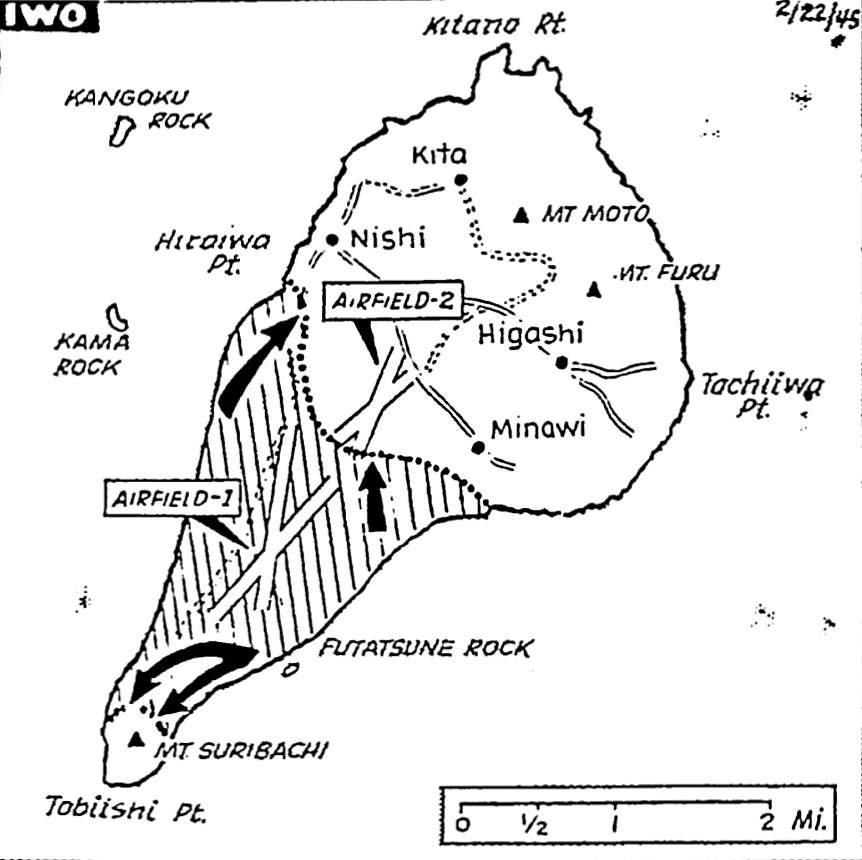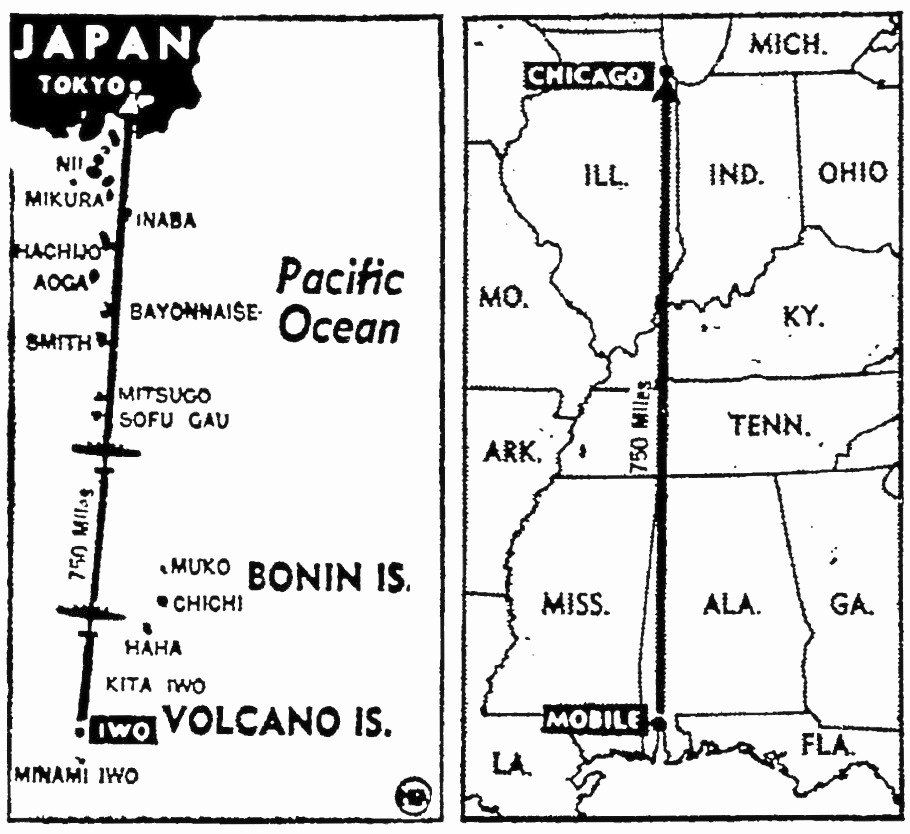U.S. Navy Department (February 22, 1945)
CINCPOA Communiqué No. 270
During the afternoon of February 21 (East Longitude Date), the attack on Iwo Island was continued in both the northern and southern sectors against increasingly heavy resistance. Intense mortar artillery and small arms fire is being encountered by our troops and in some areas extensive enemy minefields are slowing the advance. During the afternoon, there was no appreciable change in our lines.
Elements of the 3rd Marine Division began landing on the island in support of the 4th and 5th Divisions on February 21. The 3rd Division is under command of Maj. Gen. Graves B. Erskine.
In the south, flamethrowers and tanks are being used against well-entrenched enemy troops in the Mount Suribachi area. A counterattack launched by the enemy east of Mount Suribachi, shortly after noon, was thrown back. Numerous landmines have been encountered in this vicinity where four of our tanks were knocked out of action.
In the northern sector, bitter resistance was met south of the central Iwo airfield although minor gains were made by the Marines.
It is estimated that approximately 20,000 enemy troops were present on Iwo Island on D‑Day. Our forces have counted more than 850 enemy dead but information as to enemy casualties is incomplete.
During the afternoon, battleships, heavy cruisers and carrier aircraft continued to give close support to our troops with shelling and bombing.
Unloading of supplies over the beaches continues. The volume of mortar fire on the beaches is diminishing. Movement of equipment across the beaches is handicapped by very loose volcanic ash which in some sectors prevents the passage of wheeled vehicles.
CINCPOA Communiqué No. 271
During the night of February 21‑22, the northern lines of the U.S. Marines on Iwo Island successfully resisted the pressure of several heavy counterattacks accompanied by continuous enemy attempts to infiltrate into our positions.
The Marines launched an attack northward on February 22 toward the Central Iwo Airfield encountering heavy fire from small arms, mortars, and automatic weapons. At noon the troops were advancing slowly through hard rain and had knocked out numerous enemy gun positions and generally weakened the airdromes defenses. There was little change in the position of the front lines.
Coordinating their attack with the action in the northern sector our forces facing Mount Suribachi resumed the offensive. By noon they were beginning an assault on the face of the cliff under most difficult combat conditions.
Heavy naval gunfire continues on enemy‑held positions throughout the northern area of the island. In spite of the rain and adverse weather conditions, Fleet aircraft are supporting ground forces with heavy bombing, strafing and rocket attacks.
At sunset on February 21, a force of enemy bombers and fighters attacked our surface units in the area of Iwo Island causing some damage to fleet units. Seven planes were shot down by air patrols and anti-aircraft fire.
Total casualties on shore by 1745 on February 21 were estimated at 385 killed, and 4,168 wounded.
Unloading of supplies is continuing on the beaches under difficulties caused by the loose compositions of the volcano and shoreline.
CINCPOA Communiqué No. 272
The U.S. Marines on Iwo Island attacked stubbornly‑held enemy positions south of the Central Iwo airfield throughout the afternoon of February 22 making only slight gains. The attacking units continued to meet heavy rifle and mortar fire and during the later afternoon the enemy organized strong counterattacks on both flanks. Our artillery and naval guns brought these concentrations under heavy fire immediately. At about 1800 our troops appeared to have repulsed the assault on the left but no reports were available on the action on the right.
Progress was made in the assault on Mount Suribachi. By nightfall the Marines had surrounded the mountain at the southern end of the island and strong patrols were moving up the cliffs under attack by the enemy who was using hand grenades and demolition charges. Elimination of strongpoints was proceeding in this sector.
Fighting on February 22 was hampered by heavy rains.
Naval gunfire continued to support the ground troops with bombardment of enemy‑held areas of the island and carrier aircraft continued to attack.
A small group of enemy planes unsuccessfully attacked our surface forces in the area of Iwo Island and two other small groups approached it. Our fighters and anti-aircraft fire shot down six enemy planes.
Conditions on the beaches were generally improved during the day and a substantial quantity of supplies were unloaded.
At 1800 as of February 21, our casualties on Iwo Island were estimated at 644 killed, 4,168 wounded and 560 missing. A total of 1,222 enemy dead have been counted.
On February 18 (East Longitude Date), surface units of the U.S. Pacific Fleet bombarded Kurabu Saki, the southern end of Paramushiru in the Kurils.
On the following day, Liberators of the 11th Army Air Force attacked the same target. Five enemy fighters met our bombers which damaged four of the attackers. Navy search Venturas carried out rocket attacks on Minami Saki off Paramushiru on the same date damaging buildings.
Army Liberators of the Strategic Air Force, Pacific Ocean Areas, bombed the airfield on Chichi Jima and Okimura Town on Haha Jima in the Bonins on February 20.
Marcus Island was attacked with unobserved results by Army Liberators of the Strategic Air Force on the same date.
Fighters and torpedo planes of the 4th Marine Aircraft Wing attacked targets on Babelthuap in the Palaus and on Yap in the Western Carolines on February 21.
Airstrip buildings on Pagan in the Marianas were strafed by Army fighters on February 22.
Neutralizing raids were continued by Navy search planes of Fleet Air Wing Two in the Marshalls on February 21.
Operations against remnants of the Japanese garrisons on Saipan, Tinian, and Guam in the Marianas and on Peleliu in the Palaus were continued during the week ending February 17. Routine patrols mopped up 94 enemy killed and 15 captured. In addition, elements of the 24th Regiment of Army Infantry on Saipan attacked a concentration of about 350 of the enemy in a mountainous portion of the Island killing or capturing 131 Japanese on February 15, 16 and 17. Our casualties in these operations in the Marianas were seven killed and three wounded.





